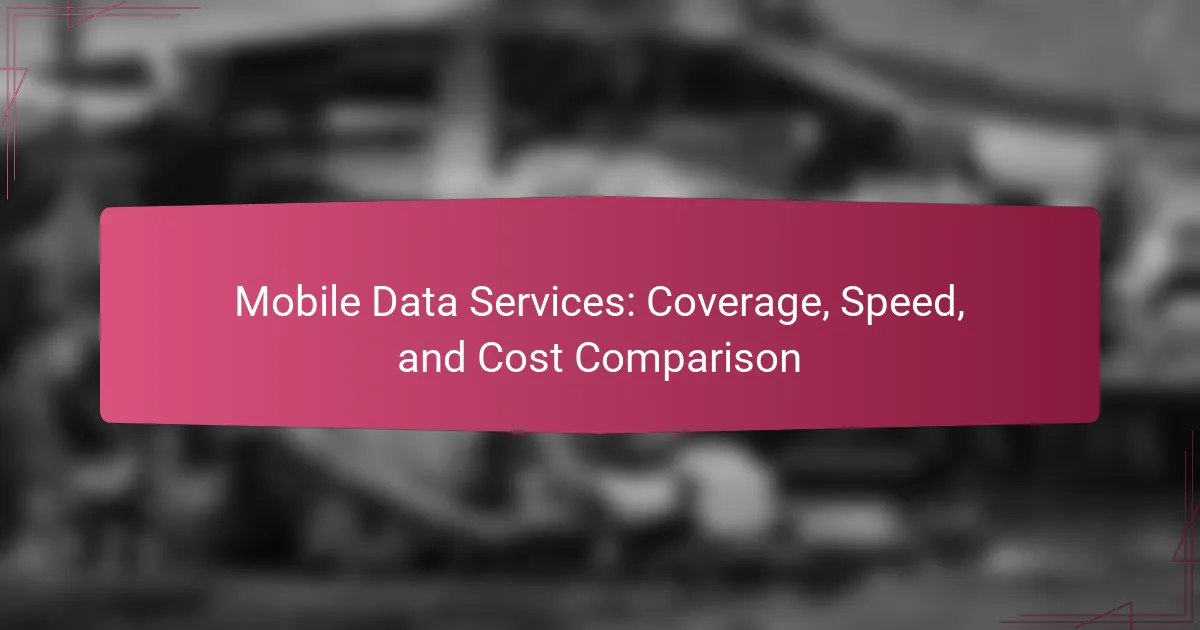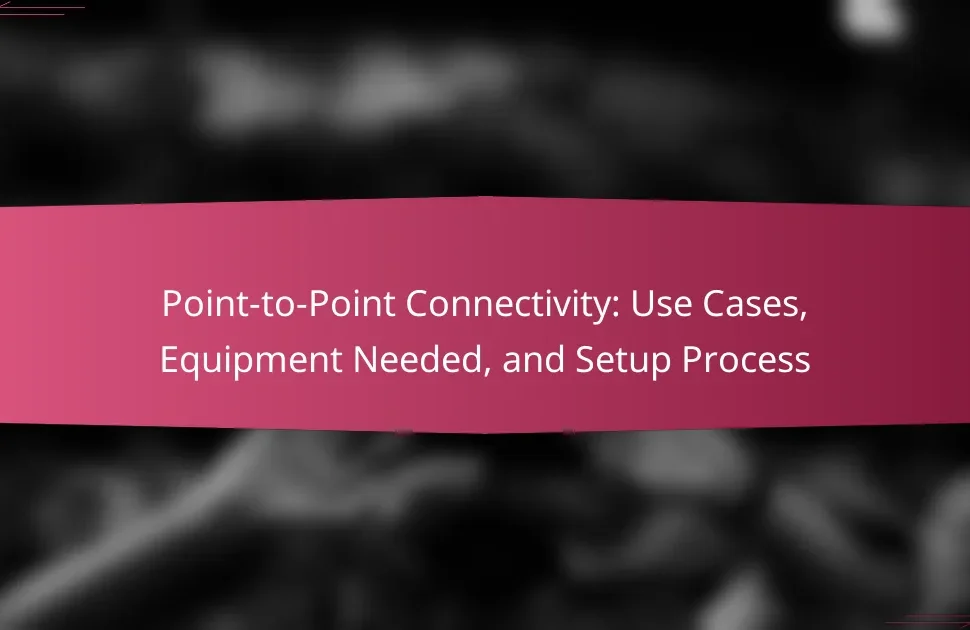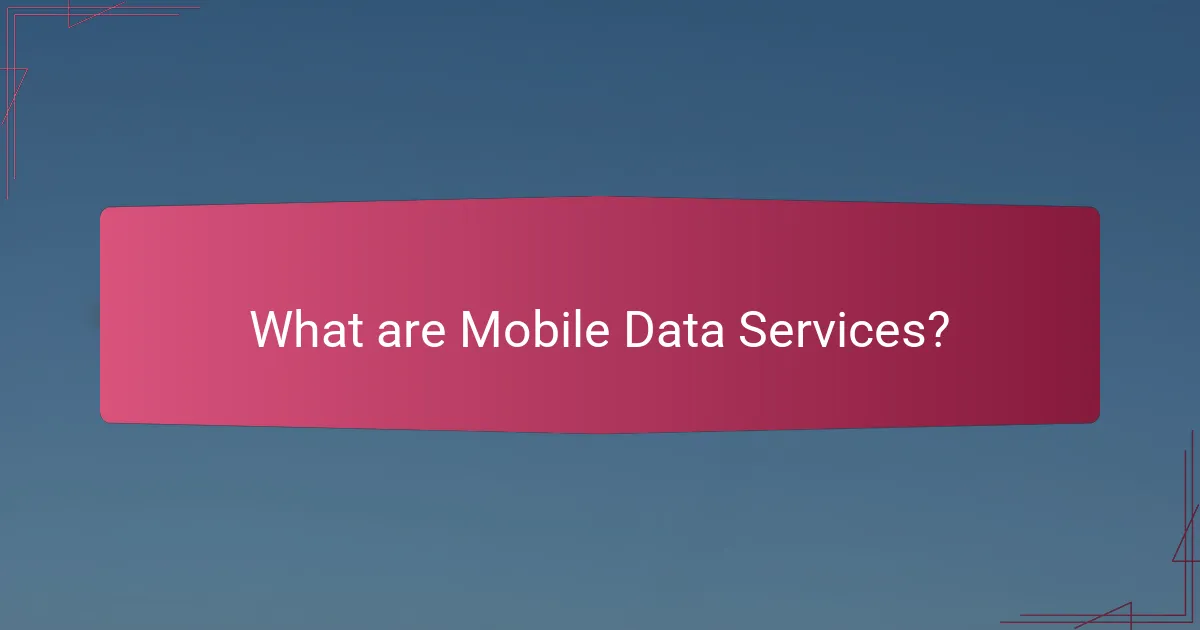
What are Mobile Data Services?
Mobile data services are telecommunications services that provide internet access via mobile networks. They allow users to connect to the internet using mobile devices such as smartphones and tablets. These services utilize cellular technology, enabling users to access data on the go. Mobile data services are essential for applications like browsing, streaming, and social media. According to the GSMA, as of 2023, there are over 5 billion mobile internet users globally. This statistic highlights the widespread reliance on mobile data services for daily activities.
How do Mobile Data Services function?
Mobile data services function by transmitting data over cellular networks. These networks consist of a series of interconnected cell towers. Each tower communicates with mobile devices using radio frequencies. When a user accesses mobile data, their device sends a request to the nearest tower. The tower then routes this request through the network to the internet. Data is transmitted back to the device in a similar manner. Mobile data services utilize various technologies, including 4G and 5G, to enhance speed and coverage. According to the GSMA, 5G networks can deliver speeds up to 10 Gbps, significantly improving user experience.
What technologies enable Mobile Data Services?
Mobile Data Services are enabled by several key technologies. These include 4G LTE, 5G networks, and Wi-Fi. 4G LTE provides high-speed data access and low latency. It supports various applications, enhancing user experience. 5G networks offer even faster speeds and greater capacity. This technology can support more devices simultaneously. Wi-Fi technology allows users to access mobile data without cellular networks. Each of these technologies plays a crucial role in providing mobile data services efficiently.
How do Mobile Data Services differ from traditional internet services?
Mobile data services differ from traditional internet services primarily in their method of connectivity. Mobile data services use cellular networks for access, allowing users to connect on the go. In contrast, traditional internet services typically rely on wired connections like DSL, cable, or fiber optics.
Mobile data services offer greater mobility, enabling users to access the internet from various locations. Traditional internet services usually require a fixed location, limiting access to specific areas.
Speed can also vary significantly. Mobile data speeds depend on network coverage and congestion, while traditional services often provide more consistent speeds due to dedicated lines.
Cost structures differ as well. Mobile data services often operate on a pay-as-you-go or subscription model with data caps. Traditional services may offer unlimited plans but can require installation fees and longer-term contracts.
These differences highlight how mobile data services cater to flexibility and mobility, while traditional internet services focus on stability and reliability.
What are the key components of Mobile Data Services?
The key components of Mobile Data Services include network coverage, data speed, and cost structure. Network coverage refers to the geographical area where mobile data is accessible. It is essential for users to have reliable connectivity. Data speed indicates how quickly information is transmitted over the network. Higher speeds enhance user experience and enable efficient data usage. Cost structure encompasses pricing plans, including pay-per-use and subscription models. These factors influence consumer choices and service provider competition. According to the Federal Communications Commission, adequate coverage and competitive pricing are crucial for service accessibility.
What role do network operators play in Mobile Data Services?
Network operators provide essential infrastructure and services for mobile data. They own and maintain the physical networks that transmit data to and from mobile devices. Network operators manage the allocation of bandwidth and ensure connectivity for users. They also implement network protocols and standards to facilitate communication.
In addition, network operators offer various mobile data plans tailored to consumer needs. They monitor network performance and optimize it for speed and reliability. Furthermore, they handle customer service and technical support related to mobile data services.
According to the GSMA, network operators play a critical role in expanding mobile data access globally. Their investments in network infrastructure have significantly increased mobile broadband coverage.
How do mobile devices interact with Mobile Data Services?
Mobile devices interact with Mobile Data Services through network connectivity and data transmission. They connect to cellular networks using radio signals. Mobile devices send requests for data, such as internet access or app usage. The Mobile Data Services process these requests and transmit the necessary data back to the device. This interaction relies on protocols that manage data flow and ensure efficient communication. For example, 4G and 5G networks provide high-speed data transfer capabilities. The efficiency of this interaction affects user experience, including speed and reliability of service.
What benefits do Mobile Data Services provide to users?
Mobile Data Services provide users with immediate access to the internet and digital resources. This connectivity supports various activities, such as browsing, streaming, and communication. Users can stay connected while on the go, without the need for Wi-Fi. Mobile Data Services enable real-time updates and notifications from apps. They also facilitate remote work and online learning, enhancing productivity. According to the Pew Research Center, 97% of Americans own a mobile phone, highlighting the widespread reliance on mobile data. Additionally, mobile data plans often offer flexibility in usage and pricing, catering to diverse user needs.
How do Mobile Data Services enhance user experience?
Mobile Data Services enhance user experience by providing reliable connectivity and fast data access. Users can stream videos, browse the internet, and use applications seamlessly. High-speed mobile data reduces buffering and loading times. Enhanced coverage ensures users remain connected in various locations. According to a report by the GSMA, 5G networks can deliver speeds up to 10 Gbps. This speed allows for real-time interactions and improved online gaming experiences. Additionally, mobile data services support multitasking across devices. Overall, these services significantly improve user satisfaction and engagement.
What are the economic advantages of Mobile Data Services?
Mobile Data Services provide significant economic advantages. They enhance productivity by enabling remote work and access to information. Businesses can reduce overhead costs by utilizing mobile solutions instead of traditional infrastructure. Mobile Data Services also promote efficiency in operations and customer engagement. According to a report by the GSMA, mobile technology contributes over $4 trillion to the global economy. This underscores the financial impact of mobile connectivity on various sectors. Additionally, mobile data facilitates better decision-making through real-time analytics. Overall, Mobile Data Services drive economic growth and innovation across industries.
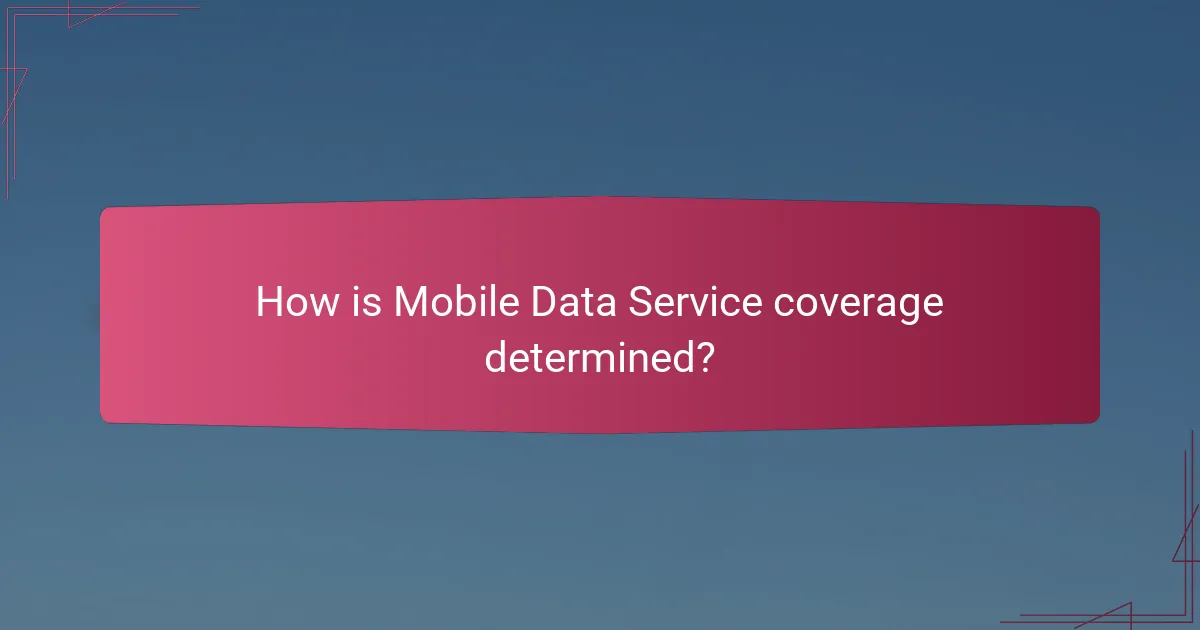
How is Mobile Data Service coverage determined?
Mobile Data Service coverage is determined by a combination of network infrastructure, signal strength, and geographic factors. Network infrastructure includes the number and location of cell towers. The density of these towers affects the availability of service in a given area. Signal strength is influenced by distance from the tower and obstacles like buildings or terrain. Geographic factors include urban versus rural settings, which can significantly impact coverage. For instance, urban areas typically have more towers, leading to better coverage. According to the Federal Communications Commission (FCC), coverage maps are created using signal propagation models and data from service providers. These maps provide a visual representation of expected coverage areas.
What factors influence Mobile Data Service coverage?
Mobile Data Service coverage is influenced by several key factors. These factors include geographical terrain, which affects signal propagation. Urban areas typically have better coverage due to higher infrastructure density. In contrast, rural areas may experience gaps due to fewer cell towers.
Another factor is the frequency band used by the service provider. Lower frequency bands offer wider coverage but lower data speeds. Higher frequency bands provide faster data rates but have limited range and [censured].
Network technology also plays a role. Technologies like 4G and 5G provide varying levels of coverage and speed. The availability of backhaul infrastructure, such as fiber optics, is essential for maintaining service quality.
Environmental factors, such as buildings and natural obstacles, can obstruct signals. Weather conditions may also temporarily affect service quality.
Lastly, the number of active users on a network can impact coverage. High user density can lead to congestion, reducing effective coverage.
How do geographical features affect coverage?
Geographical features significantly affect mobile data coverage. Mountains, valleys, and buildings can obstruct signals. Dense forests may also limit signal reach. Urban areas often have better coverage due to infrastructure. In contrast, rural regions may experience gaps in service. According to the Federal Communications Commission, terrain accounts for 30% of coverage variability. Additionally, elevation can impact the distance signals travel. Higher locations typically provide broader coverage areas. Thus, geographical features play a crucial role in determining mobile data service availability.
What impact do infrastructure and technology have on coverage?
Infrastructure and technology significantly impact mobile data coverage. Robust infrastructure, including cell towers and fiber optic cables, enhances signal strength and range. Advanced technology, such as 5G networks, provides faster data speeds and lower latency. According to the Federal Communications Commission, areas with dense infrastructure experience improved coverage and reliability. Furthermore, the integration of small cells and distributed antenna systems allows for better coverage in urban environments. These advancements enable service providers to meet increasing data demands effectively. Overall, the synergy between infrastructure and technology is crucial for optimal mobile data coverage.
How can users check Mobile Data Service coverage in their area?
Users can check Mobile Data Service coverage in their area by visiting the websites of mobile service providers. Most providers offer coverage maps that display service availability. Users can enter their address or zip code to see coverage details. Additionally, many providers have mobile apps that provide real-time coverage information. Third-party websites also aggregate coverage data from multiple carriers. These resources allow users to compare coverage across different providers. Coverage maps are updated regularly to reflect network changes. Users should check these maps before selecting a mobile data plan.
What tools are available for checking coverage?
Tools available for checking coverage include OpenSignal, CellMapper, and RootMetrics. OpenSignal provides crowdsourced data on mobile network coverage and performance. CellMapper allows users to visualize cellular coverage maps based on user-reported data. RootMetrics offers independent testing of mobile network performance across various locations. These tools utilize real-time data to help users assess the quality of mobile coverage in their area.
How reliable are coverage maps provided by service providers?
Coverage maps provided by service providers are generally useful but not always fully reliable. These maps are created using predictive modeling and historical data. They often do not account for real-time conditions like weather or physical obstructions. Coverage can vary significantly in urban versus rural areas. According to the Federal Communications Commission, actual coverage may differ from what is shown on maps. User experiences often reveal gaps in service not indicated on these maps. Therefore, while they can serve as a guideline, they should not be taken as definitive proof of service availability.
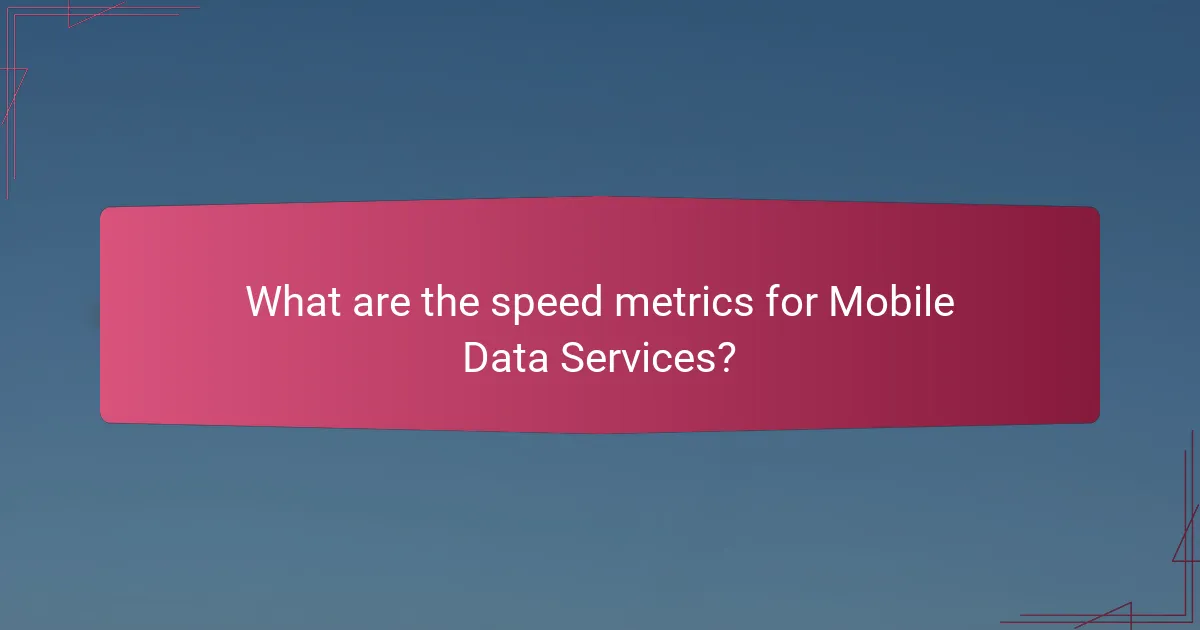
What are the speed metrics for Mobile Data Services?
Speed metrics for Mobile Data Services include download speed, upload speed, and latency. Download speed measures how quickly data is transferred to a device. It is typically measured in megabits per second (Mbps). Upload speed indicates how fast data is sent from a device to the network. Latency refers to the time it takes for data to travel from the source to the destination and is measured in milliseconds (ms).
According to the Federal Communications Commission (FCC), the average mobile download speed in the United States was approximately 50 Mbps in 2022. Upload speeds averaged around 12 Mbps during the same period. Latency for mobile networks typically ranges from 20 to 50 ms, depending on the technology used. These metrics are crucial for evaluating the performance of mobile data services.
How is Mobile Data Service speed measured?
Mobile Data Service speed is measured in megabits per second (Mbps). This unit quantifies the data transfer rate of mobile networks. Speed tests are commonly used to assess performance. These tests measure download and upload speeds. Download speed indicates how quickly data is received. Upload speed shows how fast data is sent. Tools like Ookla’s Speedtest provide real-time measurements. Operators may also report average speeds based on user data. Regulatory bodies often publish speed benchmarks for comparison.
What are the common speed metrics used in Mobile Data Services?
Common speed metrics used in Mobile Data Services include latency, download speed, upload speed, and throughput. Latency measures the time taken for data to travel from the source to the destination. Download speed indicates how quickly data is received from the internet to a device. Upload speed measures the rate at which data is sent from a device to the internet. Throughput refers to the actual rate of successful data transfer over a network. These metrics are critical in assessing the performance of mobile data services. They directly impact user experience and application performance. For instance, a download speed of 25 Mbps is often considered sufficient for streaming HD video.
How do different technologies affect speed?
Different technologies significantly affect speed in mobile data services. For instance, 4G LTE technology provides average download speeds of 5 to 12 Mbps. In contrast, 5G technology can deliver speeds exceeding 1 Gbps under optimal conditions. The type of technology influences latency as well. 4G LTE has a latency of around 30 to 50 milliseconds, while 5G can reduce this to as low as 1 millisecond. Network congestion and infrastructure also impact speed. Areas with high user density may experience slower speeds regardless of technology. Additionally, the frequency bands used by each technology play a role. Higher frequency bands can offer faster speeds but have shorter range and [censured] capabilities. Overall, advancements in technology lead to enhanced speed capabilities in mobile data services.
What factors can impact the speed of Mobile Data Services?
The speed of Mobile Data Services can be impacted by several factors. Network congestion occurs when too many users access the network simultaneously. This can slow down data speeds significantly. Signal strength is another critical factor. A weak signal results in slower data transmission rates. Distance from the cell tower also plays a role. Greater distances can lead to reduced speeds.
The technology used for the mobile network affects speed as well. For instance, 4G networks typically offer faster speeds than 3G networks. Environmental factors can also impact speed. Physical obstructions like buildings and trees can weaken signals. Additionally, the device being used can influence speed. Older devices may not support the latest technologies, resulting in slower performance.
Finally, the type of mobile plan subscribed to can determine speed. Some plans may throttle speeds after a certain data limit is reached.
How does network congestion affect speed?
Network congestion decreases speed by limiting available bandwidth. When multiple users access the same network resources, data packets experience delays. This leads to slower download and upload speeds. Studies show that congestion can reduce speeds by up to 50% during peak usage times. Increased latency occurs as devices wait longer for data transmission. The result is a frustrating user experience with buffering and slow-loading content. Therefore, network congestion directly impacts the efficiency of mobile data services.
What role does device capability play in speed performance?
Device capability significantly influences speed performance in mobile data services. Higher device specifications, such as advanced processors and better antennas, enhance data processing and transmission speeds. Devices with 4G LTE or 5G capabilities can achieve faster download and upload speeds compared to older technologies. For instance, 5G can provide speeds up to 10 Gbps under optimal conditions. Additionally, devices with more RAM and efficient operating systems can handle data-intensive applications more effectively. This leads to smoother performance and reduced latency during data transmission. Therefore, the overall capability of a device is crucial for maximizing speed performance in mobile data services.
What are the average speeds for different Mobile Data Services?
The average speeds for different mobile data services vary by technology. 3G services typically offer speeds of 1 to 3 Mbps. 4G LTE services generally provide speeds ranging from 5 to 100 Mbps. 5G networks can deliver speeds exceeding 100 Mbps, with some reports of up to 1 Gbps. These averages depend on factors like network congestion and coverage area. According to the Federal Communications Commission, the average mobile download speed in the U.S. for 4G LTE is approximately 30 Mbps. For 5G, users can experience speeds around 300 Mbps in optimal conditions.
How do 4G and 5G speeds compare?
5G speeds significantly surpass 4G speeds. 4G networks typically offer download speeds of 20 to 100 Mbps. In contrast, 5G networks can provide download speeds exceeding 1 Gbps. This means 5G can be up to 100 times faster than 4G. Additionally, 5G has lower latency, enhancing real-time communication. According to a report by the International Telecommunication Union, 5G can achieve speeds of 10 Gbps under optimal conditions. This advancement enables new technologies and applications, such as augmented reality and smart cities.
What are the speed expectations for rural versus urban areas?
Urban areas typically have higher mobile data speeds compared to rural areas. In urban settings, average download speeds can reach 50 Mbps or more. This is due to the dense infrastructure and higher number of cell towers. Conversely, rural areas often experience speeds around 10 Mbps or less. Limited infrastructure and fewer cell towers contribute to this disparity. According to the Federal Communications Commission, urban areas enjoy better service coverage and higher data capacity. This data highlights the significant difference in speed expectations between these two types of regions.
What are the costs associated with Mobile Data Services?
Mobile data services typically incur costs that include monthly subscription fees, data overage charges, and device costs. Monthly subscription fees vary by provider and plan, often ranging from $30 to $100. Data overage charges apply when users exceed their plan’s data limit, costing around $10 per additional gigabyte. Device costs include the price of purchasing a smartphone or tablet, which can range from $100 to over $1,000 depending on the model and features. Additional costs may include activation fees, taxes, and surcharges, which can add $10 to $50 to the total bill. These costs can vary significantly based on the chosen service provider and plan specifics.
What factors contribute to the pricing of Mobile Data Services?
The pricing of Mobile Data Services is influenced by several key factors. These factors include network infrastructure costs, competition among service providers, and data plan structures. Network infrastructure encompasses the expenses related to building and maintaining cell towers and data centers. Competition can drive prices down as providers seek to attract customers with better rates. Data plan structures, which include limits on data usage and speed, also play a significant role in determining costs. Additionally, geographical coverage areas can affect pricing, as more remote locations may require higher investment. According to the Federal Communications Commission, these elements collectively shape the pricing landscape of mobile data services in the market.
How do different plans and packages vary in cost?
Different mobile data plans and packages vary in cost based on data limits, contract length, and additional features. For instance, unlimited data plans typically cost more than limited data options. Monthly fees can range from $30 to over $100, depending on the provider and plan specifics. Family plans often offer discounts, lowering the cost per line. Prepaid plans usually have lower upfront costs but may lack some features of postpaid plans. Additionally, promotional offers can temporarily reduce costs for new customers. Overall, price variations reflect the balance between data allowance, service quality, and contract commitments.
What are the common pricing structures for Mobile Data Services?
Common pricing structures for mobile data services include prepaid plans, postpaid plans, and pay-as-you-go options. Prepaid plans require users to pay upfront for a set amount of data. This structure allows users to control spending and avoid unexpected charges. Postpaid plans involve a monthly subscription with a specific data allowance. Users receive a bill at the end of the month based on their usage. Pay-as-you-go options charge users based on the data consumed without a long-term commitment. These structures cater to different consumer preferences and usage patterns. According to the GSMA, global mobile data revenue reached $500 billion in 2020, reflecting the importance of pricing strategies in this sector.
What are the differences between prepaid and postpaid plans?
Prepaid plans require payment in advance for mobile services. Users pay for a set amount of data, calls, and texts before usage. This type of plan offers flexibility and no long-term contracts. Users can easily switch providers or plans without penalties.
Postpaid plans bill users after the service is used. Customers typically sign a contract for a set duration, usually 12 to 24 months. These plans often include unlimited data or higher data limits. Users may face overage charges if they exceed their plan limits.
The main difference lies in payment timing and commitment. Prepaid plans offer more control over spending. Postpaid plans may provide more extensive features and benefits.
How do unlimited plans compare to capped data plans?
Unlimited plans provide users with unrestricted data usage, while capped data plans impose a specific data limit. Unlimited plans allow for continuous internet access without worrying about overage fees. In contrast, capped plans may lead to throttling or additional charges once the limit is reached. According to a 2021 survey by the Pew Research Center, 53% of smartphone users prefer unlimited plans for their convenience. Additionally, unlimited plans often come with higher monthly fees compared to capped plans. However, capped plans can be more economical for users with lower data needs. Thus, the choice between the two depends on individual usage patterns and budget considerations.
How can users save on Mobile Data Service costs?
Users can save on mobile data service costs by utilizing Wi-Fi whenever available. Connecting to Wi-Fi reduces reliance on cellular data. Many public places, such as cafes and libraries, offer free Wi-Fi. Users should also monitor their data usage through their mobile provider’s app. Setting data limits can prevent overages and additional charges. Opting for family or shared plans can lower overall costs per line. Some carriers provide discounts for auto-pay or paperless billing. Additionally, users can consider switching to a provider with better rates or promotions.
What tips can help users choose the best plan for their needs?
Users can choose the best mobile data plan by assessing their data usage needs. Understanding how much data you consume monthly is crucial. Analyze your streaming, browsing, and app usage habits. Compare plans based on coverage in your area. Check network performance reviews for reliability. Evaluate the cost against the features offered. Look for plans with no overage fees or throttling. Consider family or group plans for potential savings. Read customer reviews to gauge satisfaction levels.
How can users optimize their data usage to reduce costs?
Users can optimize their data usage to reduce costs by monitoring their data consumption. They should regularly check their data usage through their mobile device settings or carrier apps. Limiting high-data activities, such as streaming videos in high definition, can significantly lower data consumption. Using Wi-Fi whenever available is another effective strategy. Downloading content for offline use also helps minimize data usage. Additionally, disabling background data for apps can prevent unnecessary data consumption. According to a study by the Pew Research Center, 90% of smartphone users access the internet, highlighting the importance of managing data effectively.
Mobile data services are telecommunications services that provide internet access via mobile networks, enabling users to connect through smartphones and tablets. This article covers the functioning, technologies, and key components of mobile data services, highlighting differences from traditional internet services. It also examines factors influencing coverage, speed metrics, and the economic implications of mobile data services. Additionally, the article discusses cost structures, pricing plans, and strategies for users to optimize their mobile data usage and reduce expenses.
